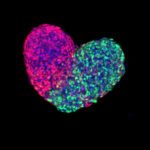Link to Pubmed [PMID] – 41020403
Link to DOI – 10.1242/dev.204711
Development 2025 Sep; 152(18):
The interplay between mechanical forces and genetic programs is fundamental to embryonic development, yet how these factors influence morphogenesis and cell fate decisions remains unclear. Here, we fine-tune the mechanical environment of murine gastruloids, three-dimensional in vitro models of early embryogenesis, by embedding them in bioinert hydrogels with tunable stiffness and timing. This strategy reveals that external constraints can selectively influence transcriptional profiles, patterning or morphology, depending on the level and timing of mechanical modulation. Gastruloids in ultra-soft hydrogels (<30 Pa) elongate robustly, preserving anteroposterior patterning and transcriptional profiles. In contrast, embedding at higher stiffness disrupts polarization while leaving gene expression largely unaffected. Conversely, earlier embedding significantly impacts transcriptional profiles independently of polarization defects, highlighting the uncoupling of patterning and transcription. These findings suggest that distinct cellular states respond differently to external constraints. Live imaging and cell tracking further suggest that impaired cell motility underlies polarization defects, underscoring the role of mechanical forces in shaping morphogenesis independently of transcriptional changes. By precisely controlling mechanical boundaries, our approach provides a powerful platform to dissect how physical and biochemical factors interact to orchestrate embryonic development.


